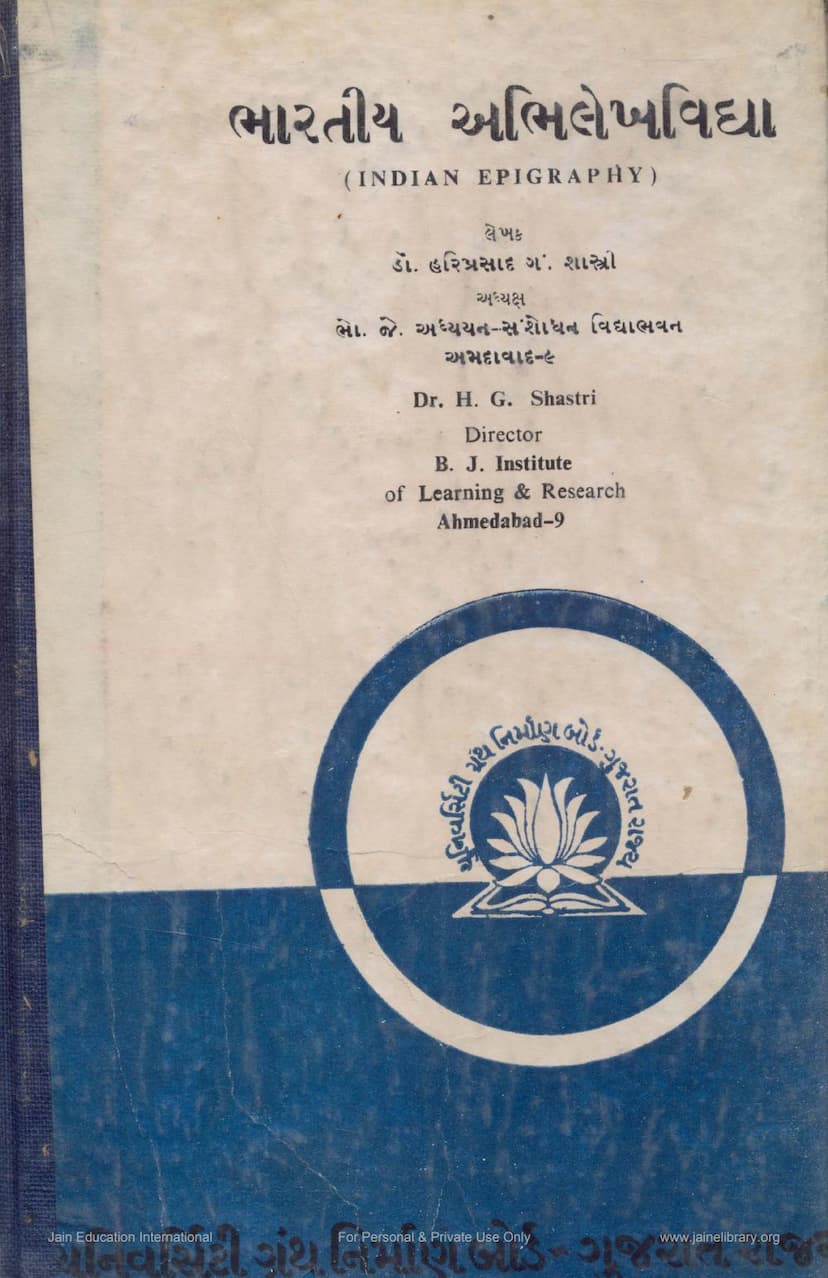Bharatiya Abhilekh Vidya
Added to library: September 1, 2025

Summary
This is a comprehensive summary of the Jain text "Bharatiya Abhilekh Vidya" (Indian Epigraphy) by Hariprasad G. Shastri, based on the provided pages:
Book Title: Bharatiya Abhilekh Vidya (Indian Epigraphy) Author: Dr. Hariprasad G. Shastri Publisher: University Granth Nirman Board, Gujarat State, Ahmedabad Publication Year: First Edition, 1973
This book is a detailed exposition of the field of Indian Epigraphy, exploring the study of inscriptions as a vital source for understanding India's history, literature, and culture.
Key Themes and Content:
-
Introduction to Epigraphy (Abhilekh Vidya):
- Defines "Abhilekh" as an inscription carved on any material, with "Shilalekh" (stone inscription) and "Tamrapatra" (copper plate) being common types.
- Highlights the importance of inscriptions as primary, contemporary sources that have survived for thousands of years, unlike other written materials.
- Explains the crucial role of "Paleography" (Prachin Lipividya) in deciphering ancient scripts, emphasizing the evolution of scripts from the Mauryan period to modern Indian scripts.
- Discusses the initiation of epigraphic studies in India from the latter half of the 18th century, noting the contributions of Western scholars in deciphering ancient scripts.
-
Antiquity of Writing and Ancient Indian Scripts:
- Explores the antiquity of writing in India, pushing it back to the Indus Valley Civilization (around 2500 BCE) based on the discovery of inscribed seals.
- Details the two main scripts used in ancient historical periods: Kharoshthi in the northwest and Brahmi in the rest of India.
- Explains that Kharoshthi script disappeared within a few centuries, while Brahmi script evolved into various regional scripts that continue to be used today.
- Discusses the origins of Brahmi script, mentioning differing theories but leaning towards an Indian origin supported by Indus script discoveries.
-
Kharoshthi Script:
- Details its name, geographical and chronological spread, features, and origin, tracing it back to Aramaic script.
- Explains its use primarily in the northwest of India and its eventual disappearance.
-
Brahmi Script:
- Traces its origin, discussing theories of foreign versus indigenous origins.
- Explains its evolution and various forms, including early and later styles, numerical symbols, and word/letter signs used in poetic compositions.
- Highlights its foundational role in the development of all modern Indian scripts, including Devanagari and Gujarati.
-
Evolution of Brahmi Script and Modern Regional Scripts:
- Details the transformation of Brahmi script through various stages, from ancient to medieval, and its divergence into regional scripts.
- Illustrates the development of Nagari and Gujarati scripts from Brahmi.
- Briefly mentions other regional scripts like Modi, Sharada, Takri, Gurmukhi, Kethi, Bengali, Maithili, Odia, Telugu, Kannada, Grantha, Malayalam, Tulu, and Tamil.
-
Indo-Muslim Scripts and Calligraphy:
- Discusses the development of Arabic, Persian, and Urdu scripts in India.
- Explains various calligraphic styles like Kufi, Naskh, Thuluth, Talik, Nastaliq, and Tughra.
-
Languages of Inscriptions:
- Lists the diverse range of languages found in Indian inscriptions, including Prakrit, Sanskrit, Tamil, Kannada, Telugu, Malayalam, Marathi, Hindi, Bengali, Kashmiri, Assamese, Arabic, Persian, and even European languages like French and English.
-
Materials and Methods of Inscription:
- Details the various materials used for inscriptions, with stone and metal (especially copper plates) being the most common.
- Explains the methods used for engraving inscriptions.
-
Subject Matter of Inscriptions:
- Categorizes inscriptions based on their content, including donation records (Danasasana), construction records (Purtanirmanalekha), idol inscriptions (Pratimalekha), prasastis (eulogies), and coin inscriptions (Sakkalekha).
-
Chronological Markers:
- Explains the importance of dating inscriptions and details various dating systems prevalent in India, such as the Vikram Samvat, Saka Samvat, Kalachuri Samvat, Gupta Samvat, etc.
-
Examples of Important Prakrit and Sanskrit Inscriptions:
- Provides the original text and Gujarati translation of significant inscriptions, including Ashoka's rock edicts, Kharavela's Hathigumpha inscription, and inscriptions of kings like Samudragupta and Rudradaman I.
- Explains the historical and cultural significance of these inscriptions.
-
Historical Importance of Inscriptions:
- Summarizes how inscriptions contribute to the study of political history, administration, geography, chronology, religion, language, literature, social and economic conditions, and architecture.
- Acknowledges the limitations and scope of epigraphic research.
-
Editing and Preservation:
- Discusses the process of discovering, reading, editing, translating, and publishing inscriptions.
- Emphasizes the importance of preserving these invaluable historical records.
Overall Significance:
"Bharatiya Abhilekh Vidya" serves as a foundational text for understanding Indian epigraphy. It systematically introduces the subject, its historical development, the various scripts and languages used, the materials and methods of inscription, and the diverse content and significance of these ancient records. The inclusion of specific examples with translations makes the text practical for students and researchers of Indian history and culture. The book underscores the indispensable role of epigraphy in reconstructing the past, providing insights that are often unavailable in literary sources.